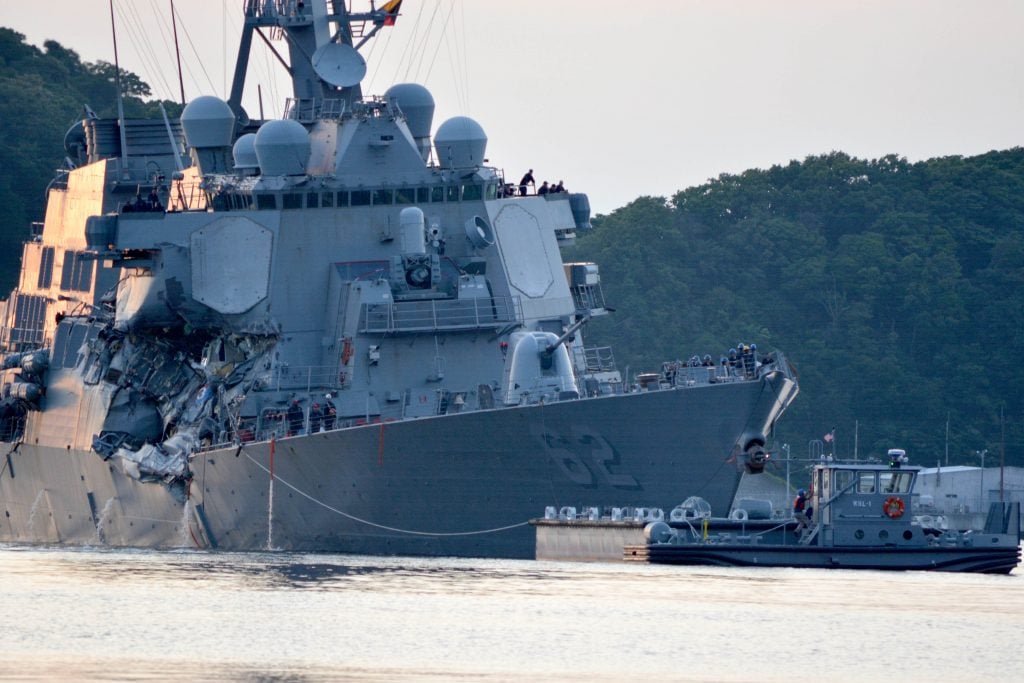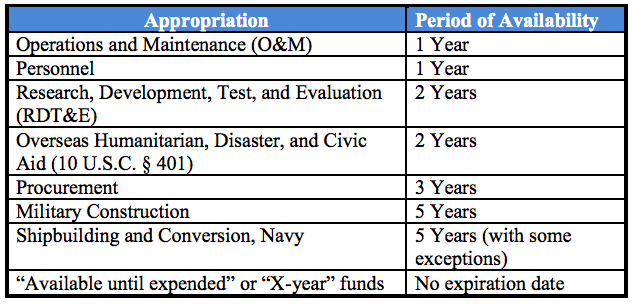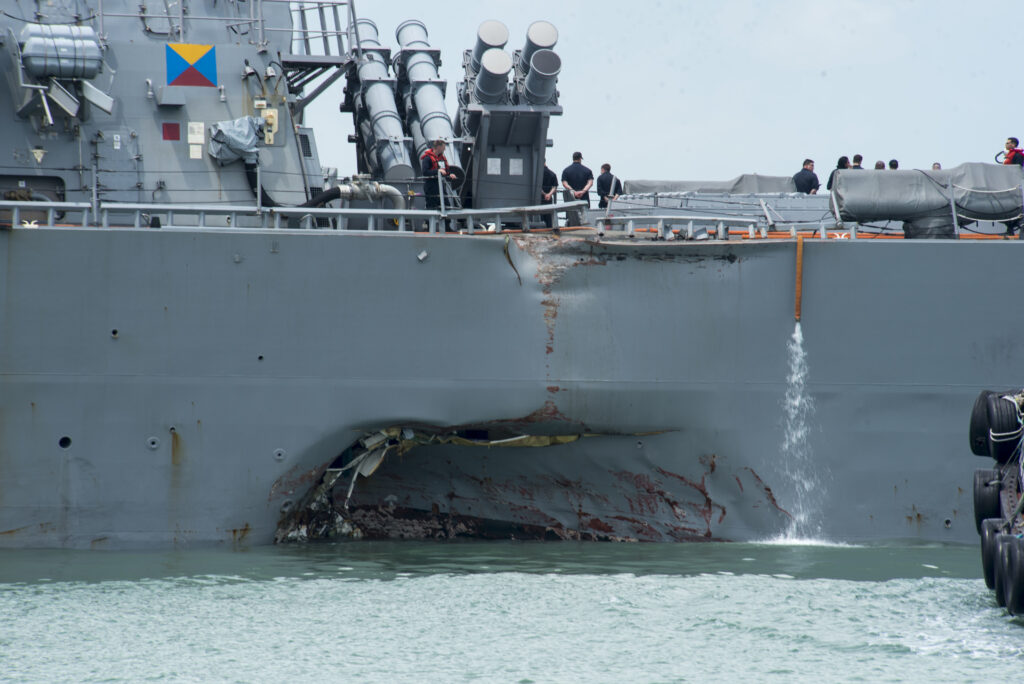
The damaged destroyer USS Fitzgerald pulls into Yokosuka, Japan after colliding with a commercial ship. Seven sailors died.
UPDATED with Harrison & Hunter analysis WASHINGTON: To prevent a repeat of last year’s lethal accidents, Senate authorizers Roger Wicker and John McCain want to give the Navy unprecedented flexibility to retain experienced officers and spend readiness funds. But the provision to let the Navy spend Operations & Maintenance money as late as in the fiscal year after it’s appropriated — instead of the current “spend it or lose it” rule — will face withering opposition from appropriators.
The so-called cardinals do not like anything that can reduce their oversight of federal spending. They have consistently opposed suggestions to pass two-year spending bills and other similar reforms which, many argue, might make the Defense Department more efficient and reduce turmoil inflicted by congressional gridlock.

Sen. Roger Wicker
“We realized that that was quite a step,” the bill’s author, Senate seapower chairman Roger Wicker acknowledged to me this afternoon, “and so we’ll have a debate. But it would enable us to see whether that concept could work for a portion of the government.”
As written, Wicker emphasized, the provision would only apply to the Navy’s Operations & Maintenance account. That’s because it’s the Navy’s Strategic Readiness Review of the deadly collisions that formally recommended additional leeway on O&M.
That said, Army Secretary Mark Esper has said that “if I had an ask of Congress along these lines — and I’ve already talked to a few members about it — I would ask this: Allow me to spend O&M money for more than one fiscal year.”
“Who knows?” Wicker mused. “It might open the way to doing that … across the board.”
Giving any service that kind of latitude, let alone the whole Defense Department, is anathema to the House and Senate Appropriations Committees, who keep discretionary spending on a tight leash. (Ironically, there’s no such control on the mandatory entitlements such as Medicare and Social Security that have ballooned to more than half of federal spending). While authorizers like McCain and Wicker get the first crack at the Pentagon budget, the Constitution gives appropriators the last word.

SOURCE: Fiscal Law Deskbook, 2014
Colors of Money
Multi-year appropriations are hardly unprecedented. Current law does allow “two-year” or “three-year” money in some accounts, like R&D and weapons procurement, where appropriators acknowledge it takes longer than a fiscal year to set up contracts. (The term of art for these differences is they’re different “colors of money.”) But Operations & Maintenance money is one-year money, which must be put on contract (or “obligated”) in the year it’s appropriated.
That’s because O&M is meant for immediate needs like spare parts, maintenance, and fuel, often bought under pre-existing, open-ended contracts. These readiness funds can be turned on and off so readily, in fact, that they’re the first thing to suffer from budget gridlock.
As that gridlock has gotten worse and worse, however, even O&M has grown harder to spend. The last nine fiscal years have started with a Continuing Resolution setting stopgap funding levels. For fiscal 2018, the Pentagon won’t have its final figures or full authority to spend them until March 23rd — almost five months into the fiscal year. That gives the Pentagon seven months to spend billions of O&M dollars above both their initial request and the Continuing Resolution levels, a recipe for haste and waste.

Todd Harrison
The Senate authorizers are hoping that this time crunch, and the fallout from last year’s 17 deaths from collisions at sea, will convince the appropriators to relent — at least on a trial basis for 2018.
UPDATE “I think extending the time for O&M funding is a smart move, but it should not be limited to Navy O&M,” said one of Washington’s leading budget experts, Todd Harrison of CSIS. “All of the services have the same issue with not having enough time left in the year to spend the money responsibly. I would even recommend that they make O&M 2-year funding from now on, not just in years when the appropriations are excessively late.”
UPDATE“There are at least two major issues…this would help with,” at both the start and the end of the fiscal year, said Harrison’s CSIS colleague Andrew Hunter, a veteran of both the Hill and the Pentagon. “The first is the incredible backloading of contracts to the very end of the fiscal year. As much as 25% of all contract obligations happen in the last month of the fiscal year and the bulk of that is in the last two weeks.”

Andrew Hunter
UPDATE“The second problem is the frequent absence of regular appropriations during CRs (Continuing Resolutions), which causes significant delays in contracting at the start of the fiscal year,” Hunter continued. “At least some of these delays could be avoided if there was a pool of regular appropriations to draw on during CRs to ensure that planned activities could proceed.”
But can this pass? Sen. Wicker sounded cautiously optimistic. “It is significant that Chairman McCain is joining me in this effort,” he told me. “That means that we have the attention of a number of people who can actually …. make this reality.”
Have you started reaching out to the appropriators or, for that matter, the House authorizers?
“I need to do that, and, yes, this will be a process,” Wicker said. “I have a pretty good track record of reaching out to the other end of the Capitol building and also across the aisle.”
It’s worth noting that the Surface Warfare Enhancement Act is not intended to pass as an act of legislation in its own right. Instead, Wicker’s doing what’s become standard for authorizers. They roll out a stand-alone bill to get attention and start debate, but ideas that actually pass do so as part of the sprawling, must-pass annual National Defense Authorization Act (NDAA).
But the authorizers and the NDAA never have the last word on how much the Pentagon can spend. And they definitely can’t dictate to the appropriators how long the Pentagon can access the funding for. The appropriators, for their part, would much rather try to fix the current process and get one-year funding passed on time — admittedly an uphill battle — than resign themselves to chronic delays and compensate by making O&M two-year money.

The USS McCain heads for Shanghai after a collision that killed 10 sailors.
Mid-Grade Officers & Training Ships
The Wicker-McCain act boasts a host of provisions beyond two-year Operations & Maintenance money. (In fact, the official press release is very vague about the O&M provision). The second-most controversial section would release all the services, not just the Navy, from restrictions on the maximum number of mid-grade officers that have stood since the Defense Officer Personal Management Act (DOPMA) passed in 1980.
DOPMA does not cap the number of junior officers, paygrades O1 through O3. (That’s lieutenants and captains in most services, ensigns and lieutenants in the Navy). DOPMA does cap the number of generals and admirals, and the Wicker-McCain bill won’t change that.

Naval Academy midshipmen train on Yard Patrol (YP) craft
What the bill would end is DOPMA caps on mid-tier or “field grade” officers. These are paygrades O4 through O6 — Navy commanders and captains, majors and colonels in the other services — who represent the experienced and professional core of the officer corps. DOPMA set limits on these ranks 38 years ago, when the military was much larger, and they’ve adjusted only slightly since.
The Navy’s Strategic Readiness Review asked for relief from the DOPMA caps, but the Senate authorizers found the Navy wasn’t using all the mid-grade officers DOPMA allowed. So the bill would let the services set their own levels for these ranks but also require them to submit them annually to Congress for review.
In addition to DOPMA, the bill would amend the Goldwater-Nichols Act of 1986, which set the current balance of power between the services and joint commanders. As requested by the Strategic Readiness Review, Wicker and McCain create a legal process by which the service chiefs can tell the Secretary of Defense a specific unit is not ready to deploy and ask him to exempt it from joint taskings.
One of the smallest items in the bill might arouse the ire of a group even more formidable than the appropriators: Naval Academy alumni. The academy has about 20 Yard Patrol (YP) boats for its midshipmen to train on, six of which are reportedly laid up. The bill will transfer some of these craft to the Navy’s training program for young Surface Warfare Officers, most of whom are Naval ROTC graduates who didn’t benefit from the Academy’s training flotilla. Undertrained and overstressed surface warship crews contributed to last year’s fatal collisions.
Updated 9:00 pm to expand explanation of multi-year appropriations.
Wicker McCain Surface Warfare Enhancement Act of 2018 2-26-18 by BreakingDefense on Scribd
US approves $6B weapons package for Ukraine, but Kyiv stalled on Patriot battery breakthrough
All equipment included in the pledge is to be ordered from industry, not drawn from US stocks — meaning it could take years for the weapons to arrive in Ukraine.

























